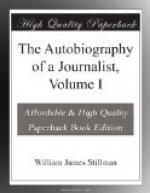In order to secure the support of the Bostonians I went to Boston and Cambridge, where I was met by a cordial response to my enthusiasm, Lowell becoming my sponsor to the circle of which he was then and for many years the most brilliant ornament. To him and his friendship in after years I owe to a very large degree the shaping of my later life, as well as the better part of the success of “The Crayon.” He was then in a condition of profound melancholy, from the recent death of his wife. He lived in retirement, seeing only his most intimate friends, and why he should have made an exception in my case I do not quite understand. It may be that I had a card of introduction from his great friend William Page or from C.F. Briggs (in the literary world, “Harry Franco"), but if so it would have been merely a formal introduction, as my acquaintance with either of those gentlemen was very slight, and I do not remember an introduction at all. My impression is that I introduced myself. But I was an enthusiast, fired with the idea of an apostolate of art, largely vicarious and due to Ruskin, who was then my prophet, and whose religion, as mine, was nature. In fact, I was still so much under the influence of the “Modern Painters” that, like Ruskin, I accepted art as something in the peculiar vision of the artist, not yet recognizing that it is the brain that sees and not the eye. But there is this which makes the nature-worshiper’s creed a more exalting one than that of the art-lover, that it is impersonal and compels the forgetting of one’s self, which for an apostolate is essential.
It was probably this characteristic of my condition which enlisted the sympathy of Lowell, who, even in his desolation, had a heart for any form of devotion, and who, with the love of nature which was one of his own most marked traits, had a side to which my enthusiasm appealed directly. The mere artist is, unless his nature is a radically religious one, an egotist, and his art necessarily centres on him, nature only furnishing him with material. I was dreaming of other things than myself or that which was personal in my enterprise, and Lowell felt the glow of my enthusiasm. He introduced me to Longfellow, Charles Eliot Norton, R.H. Dana, and other of his friends at Cambridge, and at a later visit to Agassiz, Emerson, Thomas G. Appleton (Longfellow’s brother-in-law), Whittier, E.P. Whipple, Charles Sumner, and Samuel G. Ward, banker and a lover of art of high intelligence, the friend of poets and painters, and to me, in later years, one of the kindest and wisest of advisers and friends.




